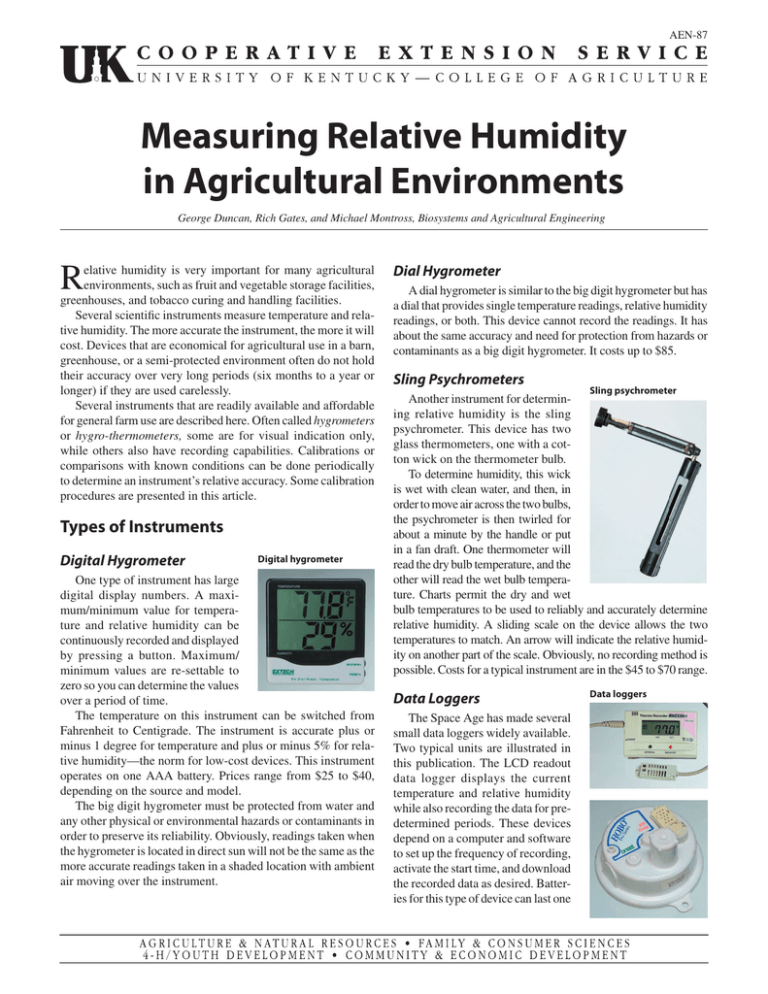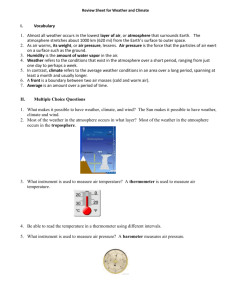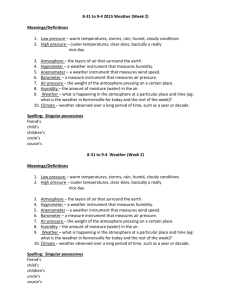AEN-87: Measuring Relative Humidity in Agricultural Environments
advertisement

AEN-87 Measuring Relative Humidity in Agricultural Environments George Duncan, Rich Gates, and Michael Montross, Biosystems and Agricultural Engineering R elative humidity is very important for many agricultural environments, such as fruit and vegetable storage facilities, greenhouses, and tobacco curing and handling facilities. Several scientific instruments measure temperature and relative humidity. The more accurate the instrument, the more it will cost. Devices that are economical for agricultural use in a barn, greenhouse, or a semi-protected environment often do not hold their accuracy over very long periods (six months to a year or longer) if they are used carelessly. Several instruments that are readily available and affordable for general farm use are described here. Often called hygrometers or hygro-thermometers, some are for visual indication only, while others also have recording capabilities. Calibrations or comparisons with known conditions can be done periodically to determine an instrument’s relative accuracy. Some calibration procedures are presented in this article. Types of Instruments Digital Hygrometer Digital hygrometer One type of instrument has large digital display numbers. A maximum/minimum value for temperature and relative humidity can be continuously recorded and displayed by pressing a button. Maximum/ minimum values are re-settable to zero so you can determine the values over a period of time. The temperature on this instrument can be switched from Fahrenheit to Centigrade. The instrument is accurate plus or minus 1 degree for temperature and plus or minus 5% for relative humidity—the norm for low-cost devices. This instrument operates on one AAA battery. Prices range from $25 to $40, depending on the source and model. The big digit hygrometer must be protected from water and any other physical or environmental hazards or contaminants in order to preserve its reliability. Obviously, readings taken when the hygrometer is located in direct sun will not be the same as the more accurate readings taken in a shaded location with ambient air moving over the instrument. Dial Hygrometer A dial hygrometer is similar to the big digit hygrometer but has a dial that provides single temperature readings, relative humidity readings, or both. This device cannot record the readings. It has about the same accuracy and need for protection from hazards or contaminants as a big digit hygrometer. It costs up to $85. Sling Psychrometers Sling psychrometer Another instrument for determining relative humidity is the sling psychrometer. This device has two glass thermometers, one with a cotton wick on the thermometer bulb. To determine humidity, this wick is wet with clean water, and then, in order to move air across the two bulbs, the psychrometer is then twirled for about a minute by the handle or put in a fan draft. One thermometer will read the dry bulb temperature, and the other will read the wet bulb temperature. Charts permit the dry and wet bulb temperatures to be used to reliably and accurately determine relative humidity. A sliding scale on the device allows the two temperatures to match. An arrow will indicate the relative humidity on another part of the scale. Obviously, no recording method is possible. Costs for a typical instrument are in the $45 to $70 range. Data Loggers The Space Age has made several small data loggers widely available. Two typical units are illustrated in this publication. The LCD readout data logger displays the current temperature and relative humidity while also recording the data for predetermined periods. These devices depend on a computer and software to set up the frequency of recording, activate the start time, and download the recorded data as desired. Batteries for this type of device can last one Data loggers Remote sensing hygromto two years. The devices can be set eter with transmitter and to take readings every 30 minutes receiver units (3,000 to 7,000 readings), with the device’s memory retaining data for 200-300 days. In most devices the data is not lost if the battery goes dead. As with the devices discussed above, data loggers will be most accurate when used in a shielded location with ambient air moving across the device. Some models are rated at plus or minus 2% accuracy for relative humidity. The cost of these devices ranges from $129 to $149 for the non-display models to $229-$249 for the display models. Probe and other circular chart recorders range from $300 to $350 each. Checking Accuracy These devices may provide accurate (plus or minus 2 to 5%) relative humidity readings when new, but prolonged enviTable 1. Relative humidity (RH) of some saturated salt ronmental factors such as dust, solutions at different temmoisture, fog, and gaseous conperatures.1 taminants can affect the sensors. Salt Temp. F RH, % The accuracy of various instruCaCl2 32 41.0 ments can be checked by putting 50 40.0 (Calcium them in a steady environment Chloride) 70 35.0 and making a comparison readNaCl 50 75.2 ing against a known high quality (Sodium 68 75.5 calibrated device. Chloride) 86 75.6 A rather simple means of NaNO 68 65.3 testing an instrument’s accu- (Sodium2 77 64.3 racy involving salt is possible Nitrate) 86 63.3 because a saturated solution of KCl 68 89.2 a readily available salt (sodium 77 87.2 (Potassium chloride, or table salt in a rather Sulfate) 86 85.3 1 pure form) has an equilibrium Hall, Carl W. 1957. Drying Farm Crops, Agricultural Consulting relative humidity of essentially Associates Inc. Reynoldsburg, 75% at a temperature of 68° to Ohio, pp 33-34. 72° F. Other commercial salt types have an equilibrium relative humidity from about 35 to 97% at room temperatures (Table 1). Here’s the method for testing accuracy: 1. Make a simple airtight chamber with a plastic container or bag. (A clear bag or container will permit reading the instrument through the enclosure during testing.) 2. Place about one-half inch of the selected salt in the bottom of a sturdy drinking cup or similar size bowl. 3. Add enough water to form a mushy mixture. Stir well. 4. Place the cup and solution in the bag or container on a firm surface in a room at the temperature shown in Table 1 and out of direct sunlight. 5. Suspend the relative humidity instrument inside the bag or chamber for one to two hours. Do not let the instrument come in contact with the salty solution or salt precipitates in the bag or chamber during the test, as damage will be done to the instrument, and all future readings will likely be in great error. 6. During the first 30 to 60 minutes of testing, you can observe the rate at which the instrument responds to the relative humidity in the enclosed bag or chamber. Part of the change is due to the time it takes for the air in the enclosure to establish equilibrium with the salt solution, and part of it is a response to the changing conditions of a new environment. 7. After a half-hour, observe the relative humidity reading periodically to determine when a steady reading has been obtained. Once you have that reading, any deviation above or below the equilibrium relative humidity will be a correction factor to be used for the instrument. (For example, if the instrument had a final steady reading of 77% for sodium chloride at 68° F (75.5% relative humidity), the device would be inaccurate by +1.5%, and all future readings in some other environment should have 1.5% subtracted from the readings. In other words, the actual relative humidity would be 1.5% lower than the meter reading. If the instrument indicates a humidity value lower than 75.5% in the test chamber, then the difference would need to be added to future readings to get a more accurate relative humidity value.) 8. Once a steady reading has been obtained and recorded, carefully remove the instrument from the enclosure and hang in the room. Notice the rate of change and how long it takes for the instrument to reach a steady reading. This time is an indication of how long an instrument should be positioned in a location before it can be expected to provide a reliable reading. Checking or calibrating a device at a given relative humidity level will enable reasonably reliable readings for 10 to 15% relative humidity above or below the calibration value. For accuracy at more extreme conditions, calibration or checking of the instrument can be done with other saturated salt solutions that are shown in Table 1. 2 Precautions Remember: The instruments discussed in this publication do not provide an immediately accurate representation of the environment in which they are first placed. Even an instrument placed in a particular environment for a period of time may not provide the accurate relative humidity if conditions are changing. For most of these devices, 15 to 30 minutes is required to reach equilibrium with the environment and provide reasonably accurate readings. If the environment is changing rapidly the instrument may not be following the dynamic changes fast enough and will have a lag in accuracy. Using an aspirated mounting (air moving past the instrument at approximately 100 feet per minute) assures much more responsive and accurate readings. Humidity above 95% can seriously affect the accuracy and stability of these instruments and should be avoided as much as possible, especially for more than a few hours. Nighttime fog and near 100% relative humidity conditions also can seriously affect the accuracy and reliability of the instruments. • Just hanging such devices in a new environment for a minute or two and expecting an accurate reading is improper and results in inaccurate data. • Any instrument used in dusty or frequently high humidity environments should be calibrated or checked for accuracy immediately after each test and before the next period of use to determine whether any adjustment factor is needed. • These instruments do not have the capability to make mechanical adjustments in order to set the readings to the standard humidity value, so numerical corrections to the final data are necessary. Use one of the methods described in this publication. Mention or display of a trademark, proprietary product, or firm in text or figures does not constitute an endorsement and does not imply approval to the exclusion of other suitable products or firms. 3 Educational programs of Kentucky Cooperative Extension serve all people regardless of race, color, age, sex, religion, disability, or national origin. Issued in furtherance of Cooperative Extension work, Acts of May 8 and June 30, 1914, in cooperation with the U.S. Department of Agriculture, M. Scott Smith, Director of Cooperative Extension Service, University of Kentucky College of Agriculture, Lexington, and Kentucky State University, Frankfort. Copyright © 2005 for materials developed by University of Kentucky Cooperative Extension. This publication may be reproduced in portions or its entirety for educational or nonprofit purposes only. Permitted users shall give credit to the author(s) and include this copyright notice. Publications are also available on the World Wide Web at www.ca.uky.edu. Issued 2-2005





